First Landing on a Comet
After two and a half suspenseful days, Rosetta mission scientists ended up a happy bunch.
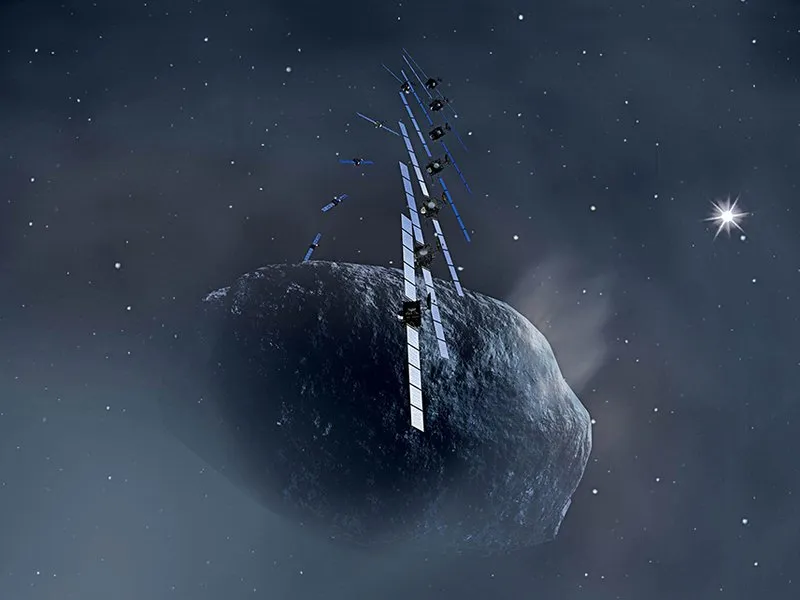
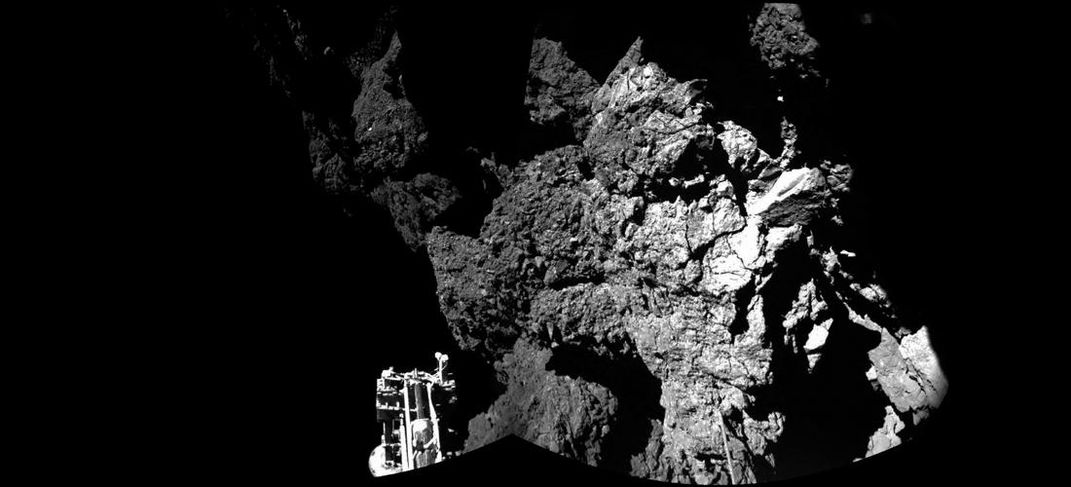
Updated November 18, 11:15 a.m. U.S. Eastern time.
Philae’s first-time landing on a comet is sure to go down as one of the most dramatic saves in the history of planetary exploration. Flight controllers and scientists in Europe ran through a gamut of emotions over the course of two and a half days, from despair that the lander might be lost, to surprise, and finally exhilaration, that they were able to get most of the science data they wanted after all.
Because the lander’s anchoring harpoons and thrusters failed to work, Philae came down in an unplanned—and still not precisely determined—location. If it had landed on a slope of greater than 30 degrees, it likely would have tipped over. At first the team thought only two legs were touching the ground, but they later concluded that all three were on solid footing. Still, as Valentina Lommatsch of the German space agency DLR put it, the spacecraft came down in a “really unlucky” spot, “in a corner, surrounded by rocks.”
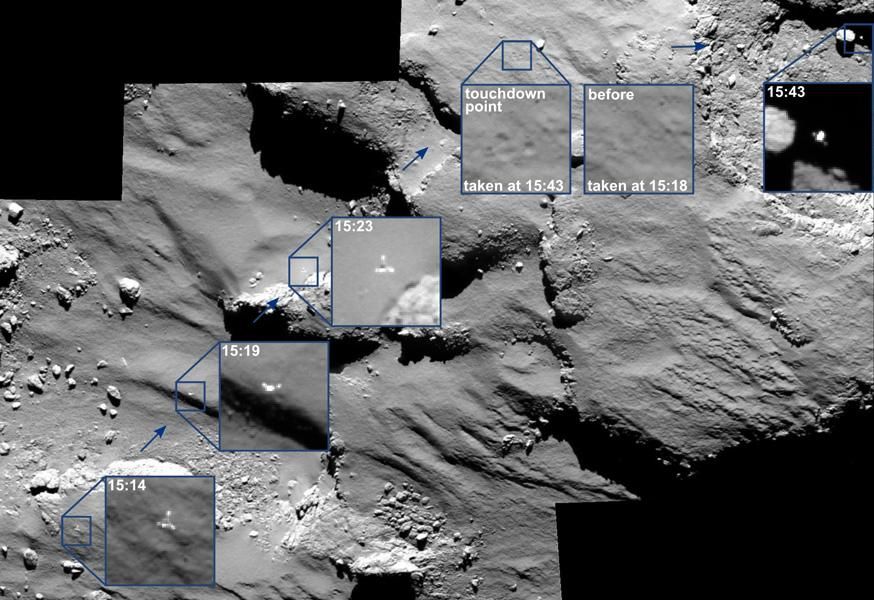
With battery life limited to 64 hours, and with little prospect of charging the craft’s solar panels in the shaded spot where it came down, the team made two daring decisions: to rotate the lander slightly to try and improve the illumination, and to go ahead and use active instruments like the SD2 drill, which was designed to collect soil samples, but which introduced motions that could have upset the precarious lander.
The gamble paid off. After the team threw out their original schedule for taking science measurements and came up with a new sequence, all of Philae’s instruments were able to collect data as the 64-hour clock ticked down. Meanwhile, the team suffered through hours of suspenseful silence, waiting for the main Rosetta spacecraft to periodically come into view so Philae could transmit its data.
The lander went into hibernation, its battery drained, early Saturday morning. But, said Stephan Ulamec, lander project manager with the German space agency, DLR, in a web post Monday, “I’m very confident that Philae will resume contact with us and that we will be able to operate the instruments again,” perhaps by next spring when the solar illumination situation improves. Ulamec had more good news in a Rosetta blog post. “Prior to falling silent, the lander was able to transmit all science data gathered during the first science sequence,” he wrote. “This machine performed magnificently under tough conditions, and we can be fully proud of the incredible scientific success Philae has delivered.”
Bonne nuit Philae. @ESA_Rosetta @Philae2014 pic.twitter.com/y4Q93oA7MB
— Philae Ptolemy (@Philae_Ptolemy) November 15, 2014Now attention shifts back to Rosetta, which will stay with the comet for the next nine months as it rounds the Sun. Despite the drama of Philae’s landing, an estimated 80 percent of the mission’s overall science return will come from the main Rosetta orbiter.
Updated November 13, 10:30 a.m. U.S. Eastern time.
Humanity’s first landing on another comet was one wild ride, and the managers of Europe’s Rosetta mission are still working to understand exactly where that ride ended yesterday, when their Philae lander touched down—then bounced two more times—to settle somewhere on the cold surface of Comet 67P/Churyumov–Gerasimenko.
Here’s what the operations team does know, as of Thursday morning: Philae did in fact land very close to its pre-planned target point, at 10:35 a.m U.S. Eastern time on November 12. The estimated touchdown site is marked in this image, taken from the Rosetta orbiter that delivered Philae to the surface.
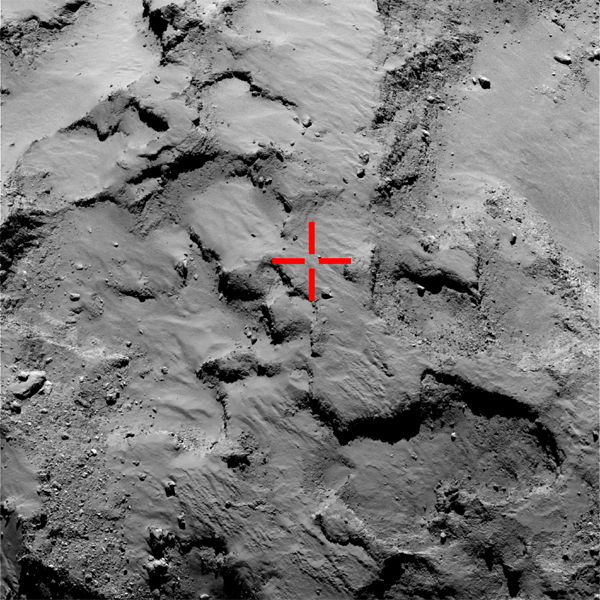
The OSIRIS narrow-angle camera on Rosetta had in fact watched the desk-size lander make its slow, seven-hour descent to the comet, its three legs already deployed and ready for contact.
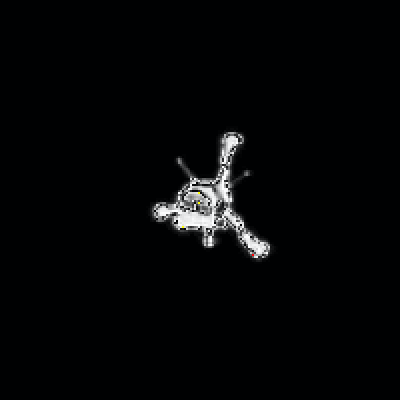
Things immediately started to go off-script at touchdown, however. Two harpoons that were meant to anchor the lander to the comet never fired, for reasons still unknown. In the near-zero gravity, that caused the lander to bounce a full kilometer back up into space. It took two hours to settle to the surface again, after which it made another short bounce, then finally stopped—somewhere.
The operations team is still trying to figure out where. The good news is that they’re in radio touch with the lander, or at least during the intervals when Rosetta is in range to receive its signals, and the science instruments are already taking measurements.
By analyzing engineering data from Philae, and studying pictures like the one below, taken by the onboard CIVA imager, the team can tell that the lander has two legs on the “ground” and one suspended in “mid-air.” It’s perched close to a rocky wall, and is partly in shadow.
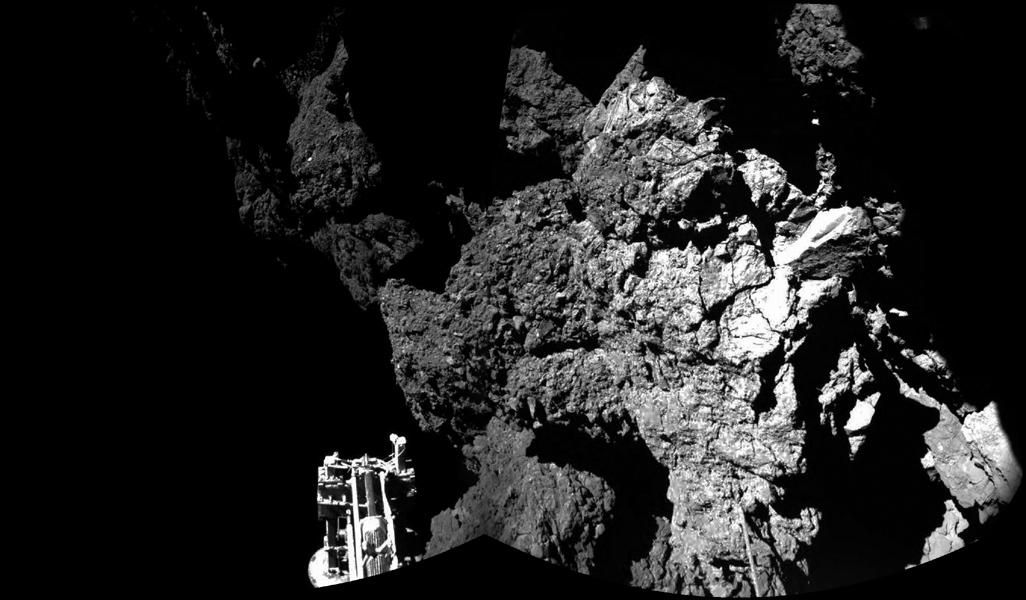
The shadow is a problem. Philae’s primary battery has a lifetime of just 64 hours, which was meant to power (and already is) an intense sequence of early observations by the onboard scientific instruments. After that, solar arrays are supposed to start charging whenever sunlight hits the lander. Mission designers had counted on six or seven hours of sun a day, which still will only power the instruments for a couple of hours every two days, after the main battery expires. Because the spacecraft has settled in a shady spot, the charging time will be more like an hour and a half a day. The scientists will just have to make the best of it.
That is, unless they can move the spacecraft to a more favorable orientation. But with one leg lifted precariously, and with no sure understanding of their position, the team is reluctant to move anything until they know the situation better. That means an onboard drill—a critical experiment for examining what’s beneath the surface of the comet nucleus—can’t be turned on as scheduled for fear of tipping over the lander or otherwise making matters worse.
So for Philae, it will be a suspenseful second day on the comet. The operations team expects to regain radio contact this afternoon through Rosetta, which should help them better understand their predicament.
Original pre-landing post (November 11):
There’s nothing in the field of planetary exploration quite as rare, or as much fun, as a first-time landing on another world. And we’re about to see one tomorrow.
Sometime around 11:00 a.m. U.S. Eastern time on Wednesday (the exact time could vary if course corrections are needed), spacecraft controllers in Europe hope to get the signal that a three-legged, desk-size spacecraft named Philae has made history’s first soft landing on the dusty nucleus of a comet -- .
In fact, this will be the first true landing on any of the so-called “small bodies” of the solar system. The Soviet Union claimed the first planetary landing when Venera 7 touched down on Venus in 1970, four years after another Soviet spacecraft, Luna 9, made the first soft lunar landing. In 2005, Europe’s Huygens lander was the first to reach the surface of another planet’s moon—Saturn’s Titan.
But when it comes to small bodies, all previous spacecraft contacts have either been quick touches (Hayabusa), unplanned, slow descents to the surface (NEAR-Shoemaker), or full-on smashups (Deep Impact). Philae’s will be the first landing on a comet nucleus with the intent to stick around and explore.
When the makers of “Deep Impact” (the movie, not the spacecraft) had to guess what a comet landing would look like in 1998—six years before Philae and its parent spacecraft, Rosetta, were launched—here’s what they came up with:
Rosetta mission designers, not facing a worldwide emergency like Robert Duvall and his crew did in the film, could choose to arrive at comet 67P/Churyumov-Gerasimenko when it was still relatively quiet, before the heat of the sun triggered the release of gas and dust. Since August, Rosetta has been orbiting the comet, most recently from a range of only four and half miles from the surface, taking photographs and scientific measurements.
The engineers relied on their new knowledge of the comet’s mass, gravity, and surface properties to chart Philae’s course to the surface. Having raised Rosetta’s orbit to 30 kilometers to get a better descent trajectory for the lander and ensure that it lands in sunlight, Philae will separate from Rosetta early Wednesday morning, at about 3:35 a.m. U.S. Eastern time (see the timeline here). The lander will take seven hours to descend to the surface. Precise timing, velocity, and orientation of the separation is critical. Even an error of a centimeter per second in the velocity could put the lander off course by hundreds of meters by the time it reaches the surface, said flight director Andrea Accomazzo in a briefing last week.
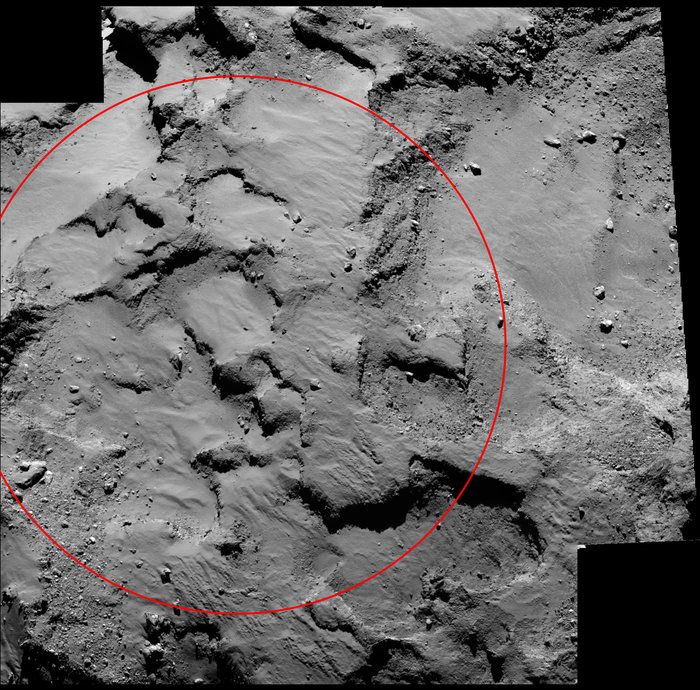
Project scientists spent weeks studying Rosetta’s pictures, looking for a smooth place to land (above). Once it’s committed to a final descent trajectory, Philae will be on its own, and won’t be able to alter its course. If a giant boulder is in the way, “that, unfortunately, is totally outside our control, said Accomazzo. “We have to be a bit lucky.”
Landing on a comet nucleus, with its neglible gravity, won’t be like landing on Mars. The impact will be at just a couple of feet per second—walking speed—after which two harpoons will fire to anchor the spacecraft to the dusty rock. The lander has thrusters, but they fire upward, to press the lander down so it doesn’t rebound too wildly while cables attached to the harpoons are reeled in to secure it to the surface.
Then, if all goes well, the exploration begins. The lander is expected to keep working until March, by which time the comet will be too hot for Philae to survive. Here’s a short video showing the first couple of days of surface operations, when Philae will take panoramic photos and scientific measurements.
All of the action will be webcast here, and the Rosetta main site has plenty of information about the mission and tomorrow’s landing.


